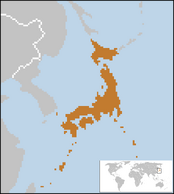|
Empire of the Tokugawa Shogunate 徳川幕府 Tokugawa Bakufu | ||
|---|---|---|
|
Flag  Crest  | ||
|
Government Seal of the Tokugawa Shogunate thumb|94px|link=File:Government_Seal_of_Tokugawa_Shogunate.png
| ||
|
Anthem IDK | ||
 | ||
|
Edo | |
|
Largest City |
Kyoto | |
|
Japanese | |
|
Shinto, Buddhism, major atheism | |
|
Japanese | |
|
Absolute Monarchy under a Military dictatorship | |
|
- - - |
Emperor Shogun Rōjū |
Ankiniro Sustika Tokgawa Shunkon Ōuykou Hunite |
|
Legislature |
Shogunate Faction | |
| - | Upper house | House of Peers |
|
- |
Lower House |
House of Represenatives |
|
Formation | ||
|
- - - - |
Something Something Something Something |
Some date Some date Some date Some date |
| Population | ||
|
- |
2038 Census |
156,986,324 |
|
377,944 sq km 0.8 | |
|
AU $8.318 trillion AU $47,735 AU $8.372 trillion AU $47,861 | |
|
Currency |
Ryō (R) / 両 | |
|
Date format |
yyyy-mm-dd | |
|
Drives on the |
Left | |
|
Internet TLD |
.jp | |
Empire of Tokugawa Shogunate (Japanese: 徳川幕府の帝国 Tokugawa Bakufu no Teikoku), also knowned as the Togukawa Shogunate, Tokugawa Bakufu, Edo Bakufu and EoTS is an island nation in East Asia. Located in the Pacific Ocean. It lies to the east to the Sea of Japan, Dewei, Korea and Green Ukraine, stretching from the Sea of Okhotsk in the north to the East China Sea and Taiwan to the south. Orginally the Tokugawa clan, became the Shogunate in 1603.
The Togukawa Shogunate is a stratovolcanic archipelago of 6,852 islands. The four largest islands are Honshu, Hokkaido, Kyushu and Shikoku, which together comprise about ninety-seven percent of Japan's land area. Due to its location in the Pacific Ring of Fire, the Togukawa Shogunate is substantially prone to earthquakes and tsunamis, having the highest natural disaster risk in the developed world. The Togukawa Shogunate has the world's ninth-largest population, with over 150 million people. Honshū's Greater Edo Area, which includes the de facto capital of Edo and several surrounding prefectures, is the largest metropolitan area in the world, with more than 26 million residents.
Etymology[]
The name Tokugawa Shogunate (Japanese: 徳川幕府の帝国 Tokugawa Bakufu) had originated from the first family member of the Tokugawa clan. The Tokugawa clan later rised to, and announced by the Emperor as the Tokugawa Shogunate. After Westernazation, it became an Empire, while still holding it's roots.
Government and Politics[]
The Tokugawa Shogunate is an Empire with a military dictatorial rule. The position that the Tokugawa Shogunate is in is very much similer to today's United States. It's a single nation comprised with daimyo states. There is 4 noble clans ruling over the area, and over 100 name clans. The current Empeor, Ankiniro Sustika, has held Imperial Authority over all of Japan. The Emperor is currently the Head of State of all of Japan. While shown as a figure of power, in comparison to the Shogun, the Emperor now is simply a figure-head. The Shogun is where true power in Japan is shown. Currently the Head of Governman as well as Head of the Military, Navy, and Air. While not fully seen as Divine Power in Japan, the Tokugawa Shogunate's military power has proved otherwised. The Rōjū usually translated as Elder, was one of the highest-ranking government posts in the Tokugawa Shogunate. The term refers either to individual Elders, or to the Council as a whole; under the first two Shoguns, there were only two Rōjū. The number was then increased to five, later reduced to four.
